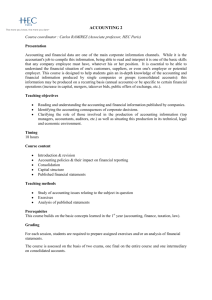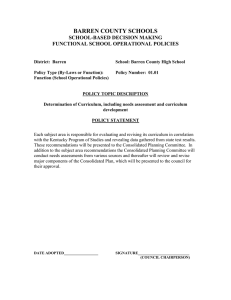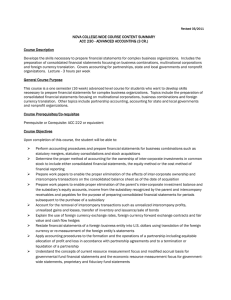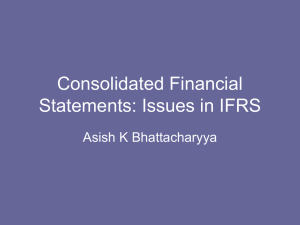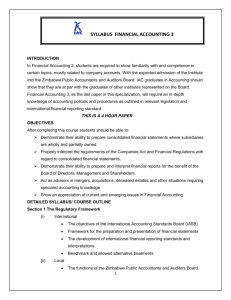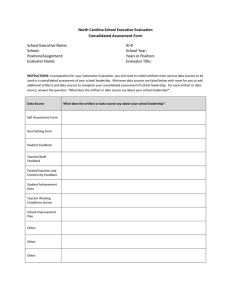consolidated financial statements and investments in subsidiaries
advertisement
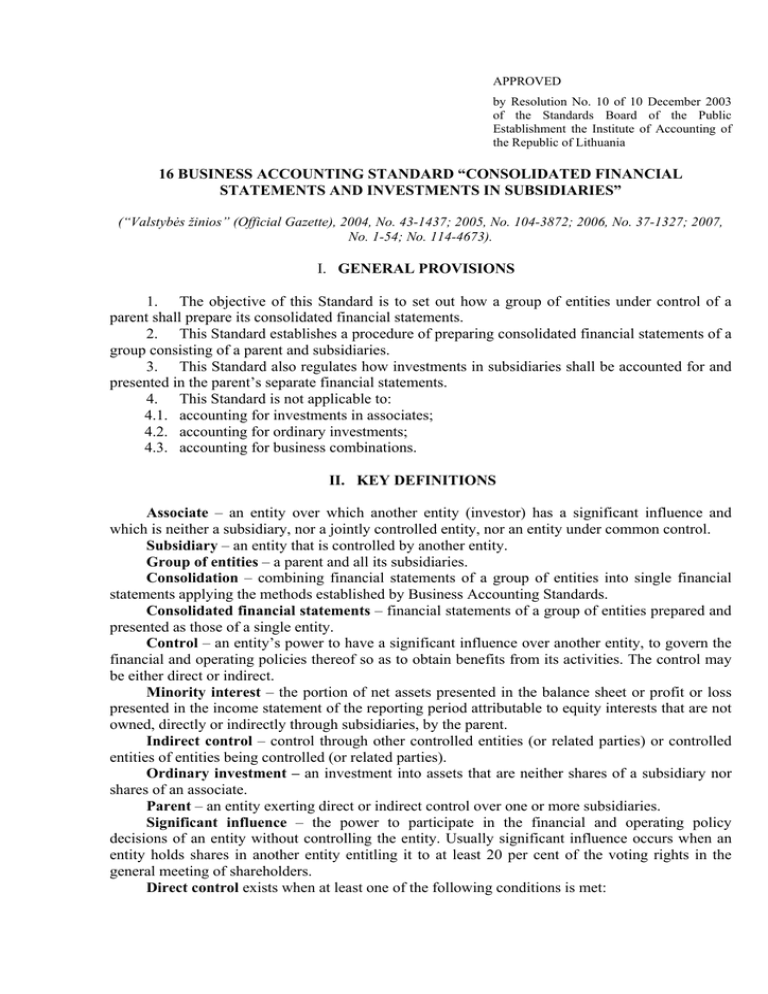
APPROVED by Resolution No. 10 of 10 December 2003 of the Standards Board of the Public Establishment the Institute of Accounting of the Republic of Lithuania 16 BUSINESS ACCOUNTING STANDARD “CONSOLIDATED FINANCIAL STATEMENTS AND INVESTMENTS IN SUBSIDIARIES” (“Valstybės žinios” (Official Gazette), 2004, No. 43-1437; 2005, No. 104-3872; 2006, No. 37-1327; 2007, No. 1-54; No. 114-4673). I. GENERAL PROVISIONS 1. The objective of this Standard is to set out how a group of entities under control of a parent shall prepare its consolidated financial statements. 2. This Standard establishes a procedure of preparing consolidated financial statements of a group consisting of a parent and subsidiaries. 3. This Standard also regulates how investments in subsidiaries shall be accounted for and presented in the parent’s separate financial statements. 4. This Standard is not applicable to: 4.1. accounting for investments in associates; 4.2. accounting for ordinary investments; 4.3. accounting for business combinations. II. KEY DEFINITIONS Associate – an entity over which another entity (investor) has a significant influence and which is neither a subsidiary, nor a jointly controlled entity, nor an entity under common control. Subsidiary – an entity that is controlled by another entity. Group of entities – a parent and all its subsidiaries. Consolidation – combining financial statements of a group of entities into single financial statements applying the methods established by Business Accounting Standards. Consolidated financial statements – financial statements of a group of entities prepared and presented as those of a single entity. Control – an entity’s power to have a significant influence over another entity, to govern the financial and operating policies thereof so as to obtain benefits from its activities. The control may be either direct or indirect. Minority interest – the portion of net assets presented in the balance sheet or profit or loss presented in the income statement of the reporting period attributable to equity interests that are not owned, directly or indirectly through subsidiaries, by the parent. Indirect control – control through other controlled entities (or related parties) or controlled entities of entities being controlled (or related parties). Ordinary investment – an investment into assets that are neither shares of a subsidiary nor shares of an associate. Parent – an entity exerting direct or indirect control over one or more subsidiaries. Significant influence – the power to participate in the financial and operating policy decisions of an entity without controlling the entity. Usually significant influence occurs when an entity holds shares in another entity entitling it to at least 20 per cent of the voting rights in the general meeting of shareholders. Direct control exists when at least one of the following conditions is met: 2 1) an entity holds shares in another entity which entitle it to more than half of the voting rights; 2) an entity holding shares in another entity, which entitle it to less than half of the voting rights, has a power to appoint or remove the head of the administration of that other entity and the majority of the members or the board or supervisory board; 3) an entity holding shares in another entity, which entitle it to less than half of the voting rights, has a power to cast more than half of the votes awarded by the shares of that other entity by virtue of agreements with other shareholders of that entity. Fair value – amount for which an asset or a service could be exchanged, or a liability settled, between knowledgeable, willing parties in an arm’s length transaction. III. ACQUISITION DATE 5. The acquisition date of a subsidiary is the day when the actual control over a subsidiary is transferred to the parent. The acquisition date does not necessarily coincide with the moment of conveying the right of ownership or the moment of cash payment. 6. As from the acquisition date performance results, assets and liabilities of a subsidiary shall be included in consolidated financial statements. 7. If a subsidiary - parent relationship arise between entities, the parent shall require that the subsidiary prepares its financial statements as of the date which is as close as possible to the acquisition date. This provision may be omitted when the maximum of two months remain until, or have passed after, the preparation of regular financial statements of the subsidiary. IV. NUMBER OF VOTES HELD BY A GROUP OF ENTITIES IN THE GENERAL MEETING OF SHAREHOLDERS OF ANOTHER ENTITY 8. The total number of votes in the general meeting of shareholders of another entity is calculated by deducting from the votes awarded by shares issued by the entity: 8.1. the votes awarded by the entity’s own shares; 8.2. the votes awarded by not fully paid up shares. 9. The total number of votes of a group of entities in the general meeting of shareholders of a separate entity is calculated by summing up the votes: 9.1. directly held by the parent; 9.2. directly held by entities in that group of entities; 9.3. of individuals acting on behalf (for the benefit) of the parent or subsidiary of the group of entities. 10. The total number of votes of the group of entities in the general meeting of shareholders of another entity calculated in the manner established by paragraph 9 is reduced by subtracting the votes awarded by shares received for management to secure a discharge of obligations, when the agreement provides for using the voting rights of such shares in the interests of another person. 11. Excluded from the total number of votes of the group of entities in the general meeting of shareholders of another entity are: 11.1. the votes in the general meeting of shareholders belonging to parties that are neither the parent of the group of entities, nor its subsidiary, nor related parties; 11.2. the votes awarded by own shares of that other entity; 11.3. the votes awarded by shares subscribed but not fully paid up by the group of entities. V. PROCEDURE OF MEASURING ASSETS IN CONSOLIDATED FINANCIAL STATEMENTS 12. Consolidated financial statements shall be prepared according to the same accounting methods and measurement rules as those applied in preparing financial statements (1 Business 3 Accounting Standard “Financial Statements”) and following the requirements established for business combinations (14 Business Accounting Standard "Business Combinations”). 13. If accounting methods and assets’ measurement rules applied by a subsidiary differ from those used by the parent, the latter shall: 13.1. perform a new valuation, except in cases when results of the new valuation would be insignificant; 13.2. not perform a new valuation if measurement rules applied by the subsidiary are acceptable in economic or legal terms for valuation of the given assets. 14. Assets and liabilities of a subsidiary operating abroad as well as its income and expenses are converted into the reporting currency of consolidated financial statements in with the manner established by 22 Business Accounting Standard “Changes in Foreign Exchange Rates”. 15. The difference of converting into litas monetary items, income and expenses of a foreign subsidiary attributable to the group of entities is presented in the consolidated income statement and the conversion difference of non-monetary items – in a separate item of “Effects of exchange rate changes” in the equity part of the consolidated balance sheet. IV. COMPOSITION OF CONSOLIDATED FINANCIAL STATEMENTS 16. Consolidated financial statements comprise: 16.1. a consolidated balance sheet; 16.2. a consolidated income statement; 16.3. a consolidated cash flow statement; 16.4. a consolidated statement of changes in equity; 16.5. explanatory notes. 17. All elements of financial statements specified in paragraph 16 shall comprise an integral whole. V. REQUIREMENTS FOR CONSOLIDATED FINANCIAL STATEMENTS 18. Consolidated financial statements shall be prepared so as to present fairly in all material respects the financial position of the group of entities, their performance and cash flows, the origin and amount of assets, liabilities, capital and reserves, contingent rights and obligations at the balance sheet date, as well as the substance and amounts of income and expenses, inflows and outflows of the given reporting period. 19. Non-compliance with the provisions of Business Accounting Standards are allowed, where in exceptional cases the application of any Business Accounting Standard is likely to result in the insufficiently fair presentation of the financial position, performance or cash flows of the group of entities. Each such case of non-compliance, reasons for it and the effect on assets, liabilities, financial position and performance shall be disclosed in explanatory notes. 20. Consolidated financial statements shall reflect all assets, liabilities and equity of entities being consolidated as of the balance sheet date, also their income and expenses related to the reporting period for which the income statement is prepared, as well as monetary inflows and outflows for the period covered by the cash flow statement. 21. Consolidated financial statements of a parent and its subsidiaries shall be prepared as of the same reporting date. 22. Consolidated financial statements may be prepared on the basis of the data for a different date, if this date is a reporting date for preparing balance sheets of the majority of the largest subsidiaries. Where the reporting dates for separate and consolidated financial statements are different and it is impractical to prepare separate financial statements before the consolidation date, financial statements of such entity can be consolidated using the data for another reporting date. For the purposes of consolidation, the difference in the dates of separate and consolidated financial statements shall not exceed three months. 4 23. An entity shall be treated as a subsidiary and its financial statements shall be consolidated if its activities are subject to direct or indirect control. The portion of the subsidiary’s equity and profit of the reporting year attributable to the group of entities is determined according to the number of votes held by the group of entities in the general meeting of shareholders of the subsidiary. 24. If a parent loses control over a subsidiary, in consolidated financial statements it shall present only the results of the subsidiary until the day of cessation of control. If after losing control the parent still holds a portion of the former subsidiary’s shares, they shall be included in financial statements under the equity method or as an ordinary non-current or current investment. The accounting treatment of such investments depends upon the portion of shares owned and intentions of the parent. 25. In exceptional cases set by the Law on Consolidated Financial Statements of Entities, financial statements of subsidiaries may not be consolidated. Investments in subsidiaries whose financial statements are not consolidated are presented in consolidated financial statements under the equity or fair value method. 26. An entity can be controlled by a natural person or a group of natural persons acting on the basis of an agreement. If these natural persons or their group are not required by laws to prepare financial statements and control exercised by them is not treated as a business combination, entities being controlled are not treated as a group of entities and their financial statements are not consolidated. 27. If an entity registered in the Republic of Lithuania decides at its own discretion to prepare consolidated financial statements without being required to do so by laws of the Republic of Lithuania, it shall observe this Standard. VI. PREPARATION OF CONSOLIDATED FINANCIAL STATEMENTS 28. Before consolidating financial statements it is necessary to: 28.1. make sure that subsidiaries have applied the same accounting rules and methods for measuring their assets and liabilities; 28.2. reconcile the results of intragroup transactions and their closing balances; 28.3. convert into litas financial statements of subsidiaries registered abroad. 29. Consolidated financial statements are prepared in accordance with the following consolidation procedures: 29.1. financial statements of the parent and its subsidiaries are combined on a line-by-line basis by adding together like items; 29.2. all results of intragroup operations and transactions (income and expenses, inflows and outflows); dividends of an entity of the group attributable to other entities of the same group; written off amounts of investments in entities that belong to that group of entities or that are included in accounting under the equity method; amounts receivable from, and payable to, the group of entities; profit (loss) arising from intragroup transactions of the group of entities that is included in the value of assets or liabilities in the balance sheet, etc. are eliminated; 29.3. the portion of equity of each subsidiary, whose financial statements are being consolidated, proportional to the portion of its shares held by the group, as well as the carrying amount of such shares in entities holding shares of the subsidiary are eliminated. The portion of equity and profit (loss) of the reporting period of each subsidiary whose financial statements are being consolidated that is attributable to owners, other than the entities of that group, in consolidated financial statements shall be identified separately and presented as minority interests. 30. Goodwill and negative goodwill arising from the acquisition of subsidiary’s shares are accounted for in the manner established by 14 Business Accounting Standard “Business Combinations”. 31. The parent shall use its right of control to ensure that subsidiaries timely submit the requested information necessary for consolidation purposes. 5 IX. MINORITY INTERESTS 32. In the consolidated income statement the portion of the reporting year’s net result of subsidiaries attributable to shareholders that do not belong to the group of entities shall be presented separately as “Minority interests in the net result” item. 33. In the consolidated balance sheet the portion of equity of subsidiaries attributable to shareholders that do not belong to the group of entities shall be presented separately as “Minority interest” item that is not included either in equity, or in liabilities. 34. The portion of equity of a subsidiary attributable to minority interests comprises: 34.1. the portion of equity (net assets at fair value) attributable to minority interests calculated at the acquisition date; 34.2. the portion of changes in equity attributable to minority interests which occurred after the acquisition date. 35. Minority interests in a subsidiary presented in the consolidated balance sheet shall not be negative. If during the reporting period a subsidiary incurred losses and as a result minority interests in that entity presented in the balance sheet would become negative, the resulting negative difference shall be considered as a loss of the group of entities, except in cases when minority shareholders also assume an obligation to cover losses of the subsidiary. All losses incurred by the subsidiary in the next year shall be treated as losses of the group of entities. When the subsidiary begins generating profit, minority losses attributed to the group of entities shall have to be covered from the part of profit attributable to minority interests. X. PREPARATION OF THE CONSOLIDATED BALANCE SHEET AND INCOME STATEMENT 36. On the basis of the actual data for the financial year covered by consolidated financial statements, minority interests are calculated for each subsidiary in proportion to the portion of shares of the subsidiary which do not belong to the group of entities. In the consolidated balance sheet, minority interests in the equity of the subsidiary are presented in a separate item distinguished from equity and liabilities. Minority interests in the profit (loss) of the reporting year are presented in the income statement in a separate line following “Profit (loss) before minority interests” line. 37. In preparing the consolidated balance sheet and income statement balance sheets and income statements of the parent and subsidiaries of the same year are combined on a line-by-line basis by adding together like items. 38. All intragroup transactions and results thereof are deducted from the combined items of the balance sheet and income statement. 39. Equity of subsidiaries is eliminated from the balance sheet. The portion of equity of subsidiaries attributed to the group of entities and financial assets of the group attributable to those subsidiaries are eliminated and may be recognised as goodwill (or negative goodwill) in accordance with the procedure established by 14 Business Accounting Standard “Business Combinations”. The portion of equity of subsidiaries attributable to minority interests is eliminated and presented in the balance sheet as minority interests. 40. The value of goodwill and negative goodwill shall be reviewed on a yearly basis, recognising, where appropriate, the impairment of goodwill or negative goodwill (in the manner established by 23 Business Accounting Standard “Impairment of Assets”). 41. Amortisation of goodwill (negative goodwill) of the reporting year is calculated and recognised. The amount of goodwill amortisation increases the expenses of the reporting year and the accumulated amount of goodwill amortisation. Negative goodwill amortisation reduces the expenses of the reporting year and increases the accumulated amount of negative goodwill amortisation. 6 XI. PREPARATION OF THE CONSOLIDATED CASH FLOW STATEMENT 42. If a consolidated cash flow statement is prepared under the direct method, inflows and outflows of all entities belonging to a group of entities are included in it, except for inflows and outflows related to intragroup operations and transactions. 43. If consolidated financial statements are prepared under the indirect method, cash flows from operating activities are calculated on the basis of changes in consolidated balance sheet items. Consolidated net profit of the group of entities is reduced by the influence of minority interests, because a separate disclosure of minority interests in the consolidated income statement is not related to cash flows. 44. All cash flows shall include all inflows and outflows, except for intragroup inflows and outflows. 45. If during a reporting period shares in another entity which meets the criteria applicable to a subsidiary are acquired, in the consolidated cash flow statement the acquisition of shares of such entity shall be presented as a cash flow from investing activities equal to the difference between the amount paid for the subsidiary’s shares and its cash balances at the moment of acquisition. XII. PREPARATION OF THE CONSOLIDATED STATEMENT OF CHANGES IN EQUITY 46. The consolidated statement of changes in equity shall include all changes in equity of the group of entities of the reporting period. In the consolidated statement of changes in equity the authorised capital is equal to the parent’s authorised capital. The portion of reserves and retained earnings held by a subsidiary (subsidiaries) before the formation of a parent-subsidiary relationship shall be excluded from the consolidated statement of changes in equity. Dividends allocated to the entities of the group shall also be excluded. Changes in equity of foreign subsidiaries resulting from fluctuations in exchange rates are presented in a separate line. XIII. FORMS OF CONSOLIDATED FINANCIAL STATEMENTS 47. Standard forms of consolidated financial statements are presented in the Annexes to this Standard. If a group includes entities that prepare different forms of financial statements, the group may select the forms of its consolidated financial statements. However, these financial statements shall contain all main elements of all financial statements (2 Business Accounting Standard “Balance Sheet” and 3 Business Accounting Standard “Income Statement”) and they shall present fairly all assets, liabilities, income, expenses and cash flows of the group of entities. XIV. ACCOUNTING FOR INVESTMENTS IN SUBSIDIARIES IN SEPARATE FINANCIAL STATEMENTS OF THE PARENT 48. An investor, who has subsidiaries and prepares consolidated financial statements, in its separate financial statements accounts for investments in subsidiaries under the equity or cost method (15 Business Accounting Standard “Investments in Associates”). XV. DISCLOSING INFORMATION IN FINANCIAL STATEMENTS 49. Explanatory notes to consolidated financial statements shall contain disclosures and explanations of all main items of consolidated financial statements. 50. Explanatory notes shall be prepared as explanatory notes of a single entity. General part and accounting policies shall be prepared in accordance with the requirements set by 6 Business 7 Accounting Standard “Explanatory Notes”. Comments of explanatory notes shall include information required by this and other Business Accounting Standards and other material information that was not presented in the consolidated balance sheet, consolidated income statement, consolidated statement of changes in equity and consolidated cash flow statement but discloses the nature of operations, performance, financial position and cash flows of the group of entity as a single entity. 51. Explanatory notes shall disclose information about entities belonging to the group, specifying their exact names, addresses, types of main activities, share controlled by the group, amount of investment and profit (loss) of the reporting year. If a group holds less than 50 per cent of an entity’s shares and it is still included in consolidated financial statements, the reasons for treating such entity as a subsidiary shall be indicated. If any subsidiary is not included in consolidated financial statements, the reason thereof shall be specified in explanatory notes. 52. Any changes in the group of entities or in the accounting for investments shall be disclosed in explanatory notes. 53. If the structure of a group has changed considerably during a reporting period, consolidated financial statements shall include information which allows comparing the data of consolidated financial statements for the current and previous reporting periods. 54. If consolidation was based on financial statements of an entity prepared at the date other than the reporting date of consolidated financial statements, this shall be specified and substantiated in explanatory notes. In addition, explanatory notes shall disclose all significant facts and events related to assets and liabilities, financial position and profit (loss) of each entity, as well as its operations with other entities being consolidated, for the period from the date of annual financial statements of the given entity until the reporting date of consolidated financial statements. 55. If a subsidiary applied different methods of measuring assets or liabilities, this shall be disclosed in explanatory notes specifying the reasons for their application. XVI. FINAL PROVISIONS 56. If a subsidiary’s shares were acquired before the adoption of this Standard and the parent neither prepared consolidated financial statements nor treated such entity as its subsidiary, goodwill or negative goodwill shall be calculated using the data as of the day when this Standard becomes effective. It will comprise the difference between the acquisition cost of the group’s investment in the subsidiary and the portion of net assets thereof which is attributable to the group of entities on that day. This difference is presented in the statement of changes in equity of the reporting period by adjusting the retained earnings (losses) of the current reporting period. 57. If a subsidiary’s shares were acquired before the adoption of this Standard and the parent prepared consolidated financial statements according to International or other Accounting Standards, the parent may recognise goodwill or negative goodwill and amortise it from the day of acquisition of the subsidiary. 58. This Standard shall be effective for consolidated financial statements covering periods beginning on or after 1 January 2004. 8 Annex 1 to 16 Business Accounting Standard “Consolidated Financial Statements and Investments in Subsidiaries” (Standard Form of Consolidated Balance Sheet) (name of group of entities) (identification number, address and other data of the parent) APPROVED by Minutes No. …. …. of …… .……… 20 ….. ________________ CONSOLIDATED BALANCE SHEET (reporting period) ….. …………… No. …. (reporting date) ___________________________________ ASSETS Reporting currency – specify degree of accuracy Comment Financial Previous No. year financial year A. I. I.1. I.2. I.3. I.4. I.5. II. II.1. II.2. II.3. II.4. II.5. II.6. II.7. II.8. II.8.1. II.8.2. III. III.1. III.2. III.3. III.4. IV. IV.1. IV.2. B. NON-CURRENT ASSETS INTANGIBLE ASSETS Development work Goodwill Patents, licenses Software Other intangible assets TANGIBLE ASSETS Land Buildings and construction Plant and machinery Vehicles Equipment Construction in progress Other financial assets Investment property Land Buildings FINANCIAL ASSETS Investments in associates Loans to associates Amounts receivable after one year Other financial assets OTHER NON-CURRENT ASSETS Deferred tax assets Other non-current assets CURRENT ASSETS 9 I. I.1. I.1.1. I.1.2. I.1.3. I.1.4. I.2. I.3. II. II.1. II.2. II.3. III. III.1. III.2. III.3. IV. INVENTORIES, PREPAYMENTS AND CONTRACTS IN PROGRESS Inventories Raw materials and components Work in progress Finished goods Goods for resale Prepayments Contracts in progress AMOUNTS RECEIVABLE WITHIN ONE YEAR Trade debtors Amounts receivable from associates Other amounts receivable OTHER CURRENT ASSETS Current investments Time deposits Other current assets CASH AND CASH EQUIVALENTS TOTAL ASSETS: EQUITY AND LIABILITIES C. I. I.1. I.2. I.3. I.4. II. III. III.1. III.2. III.3. IV. IV.1. IV.2. V. D. E. F. I. I.1. I.1.1. I.1.2. I.1.3. EQUITY CAPITAL Authorised (subscribed) Subscribed uncalled authorised capital (-) Share premium Own shares (-) REVALUATION RESERVE (RESULTS) RESERVES Legal reserve Reserve for acquiring own shares Other reserves RETAINED EARNINGS (LOSSES) Profit (loss) of the reporting year Profit (loss) of the previous years EFFECTS OF CHANGES IN EXCHANGE RATES MINORITY INTEREST GRANTS AND SUBSIDIES AMOUNTS PAYABLE AND LIABILITIES NON-CURRENT AMOUNTS PAYABLE AND LIABILITIES Financial debts Leases and similar liabilities To credit institutions Other financial debts Comment No. Financial year Previous financial year 10 I.2. I.3. I.4. I.4.1. I.4.2. I.4.3. I.5. I.6. II. II.1. II.2. II.2.1. II.2.2. II.3. II.4. II.5. II.6. II.7. II.8. Debts to suppliers Received prepayments Provisions For covering liabilities and claims For pensions and similar obligations Other provisions Deferred tax liabilities Other amounts payable and non-current liabilities CURRENT AMOUNTS PAYABLE AND LIABILITIES Current portion of long-term debts Financial debts To credit institutions Other financial debts Trade amounts payable Received prepayments Income tax liabilities Liabilities related to employment relations Provisions Other amounts payable and current liabilities TOTAL EQUITY AND LIABILITIES: __________________________ ________________ (title of the parent’s head of (signature) administration) __________________________ (name and surname) 11 Annex 2 to 16 Business Accounting Standard “Consolidated Financial Statements and Investments in Subsidiaries” (Standard Form of Consolidated Income Statement) _______________________________________________________________ (name of group of entities) (identification number, address and other data of the parent) APPROVED by Minutes No. …. …. of …… .……… 20 ….. ________________ CONSOLIDATED INCOME STATEMENT (reporting period) ….. …………… No. …. (reporting date) ____________________________ Reporting currency - specify degree of accuracy Seq. No. Items Comment Financial year Previous No. financial year I. II. III. IV. IV.1. IV.2. V. VI. VI.1. VI.2. VII. SALES REVENUE COST OF SALES GROSS PROFIT (LOSS) OPERATING EXPENSES Selling General and administrative OPERATING PROFIT (LOSS) OTHER ACTIVITIES Income Expenses FINANCING AND INVESTING ACTIVITIES VII.1. Income VII.2. Expenses VIII. PROFIT (LOSS) FROM ORDINARY ACTIVITIES IX. EXTRAORDINARY GAINS X. EXTRAORDINARY LOSSES XI. PROFIT (LOSS) BEFORE TAX XII. INCOME TAX XIII. PROFIT (LOSS) BEFORE MINORITY INTERESTS XIV. MINORITY INTERESTS XV. NET PROFIT (LOSS) __________________________ (title of the parent’s head of administration) _______________ (signature) __________________________ (name and surname) 12 Annex 3 to 16 Business Accounting Standard “Consolidated Financial Statements and Investments in Subsidiaries” (Standard Form of Consolidated Statement of Changes in Equity) ________________________________________________________________________ (name of group of entities) ____________________________________________ (identification number, address and other data of the parent) APPROVED by Minutes No. …. …. of …… .……… 20 ….. __________________ CONSOLIDATED STATEMENT OF CHANGES IN EQUITY (reporting period) ….. …………… No. …. (reporting date) ____________________________ Reporting currency - specify degree of accuracy Paid up authorised capital Share premium Own shares Revaluation reserve (results) Legal reserves Of noncurrent tangible assets Legal (-) 1. Balance at the end of the reporting period before previous 2. Result of changes in accounting policies 3. Result of correcting material errors 4. Recalculated balance as at the end of the reporting period before previous Of financial assets For acqui ring own shares Other reserves Retained earnings (losses) Effects of changes in exchange rates Total 13 5. Increase /decrease in the value of noncurrent tangible assets 6. Increase /decrease in the value financial assets 7. Acquisition /sales of own shares 8. Profit/loss not recognised in the income statement 9. Net profit/loss of the reporting period 10. Dividends 11. Other payments 12. Formed reserves 13. Used reserves 14. Increase /reduction of authorised capital 15. Contributions to cover losses 16. Changes due to exchange rates 17. Balance at the end of the previous reporting period 18. Increase /decrease in the value of noncurrent tangible assets 19. Increase /decrease in the value of financial assets 20. Acquisition / sales of own shares 14 21. Profit/loss not recognised in the income statement 22. Net profit/loss of the reporting period 23. Dividends 24. Other payments 25. Formed reserves 26. Used reserves 27. Increase /reduction of authorised capital 28. Contributions to cover losses 29. Changes due to exchange rates 30. Balance at the end of the current reporting period __________________________ (title of the parent’s head of administration) _______________ (signature) __________________________ (name and surname) 15 Annex 4 to 16 Business Accounting Standard “Consolidated Financial Statements and Investments in Subsidiaries (Standard Form of Cash Flow Statement Prepared under the Direct Method) (name of group of entities) (identification number, address and other data of the parent) APPROVED by Minutes No. …. …. of …… .……… 20 ….. ________________ CONSOLIDATED CASH FLOW STATEMENT (reporting period) …… ………... No. ….. (reporting date) _______________________________ Reporting currency – specify degree of accuracy No. I. I.1. I.1.1. I.1.2. I.2. I.2.1. I.2.2. I.2.3. I.2.4. Items Cash flows from operating activities Cash inflows of the reporting period (VAT included) Inflows from customers Other inflows Cash outflows of the reporting period Cash paid to suppliers of raw materials, goods and services (VAT included) Outflows related to employment relations Taxes paid into the budget Other payments Net cash flows from operating activities II. II.1. II.2. II.3. II.4. II.5. II.6. II.7. II.8. II.9. Cash flows from investing activities Acquisition of non-current assets (excluding investments) Disposal of non-current assets (excluding investments) Acquisition of non-current investments (excluding investments in subsidiaries) Disposal of non-current investments (excluding investments in subsidiaries) Acquisition of investments in subsidiaries Disposal of investments in subsidiaries Loans granted Loans recovered Dividends and interest received Com Financial ment year No. Previous financial year 16 II.10. II.11. III. III.1. III.1.1. III.1.2. III.1.3. III.1.4. III.2. III.2.1. III.2.1.1. III.2.1.2. III.2.2. III.2.2.1. III.2.2.2. III.2.2.3. III.2.2.4. III.2.3. III.2.4. III.3. III.4. IV. IV.1. IV.2. V. VI. VII. VIII. Other increases in cash flows from investing activities Other decreases in cash flows from investing activities Net cash flows from investing activities Cash flows from financing activities Cash flows related to entity owners Issue of shares Owners’ contributions against losses Purchase of own shares Payment of dividends Cash flows related to other financing sources Increase in financial debts Loans received Issue of bonds Decrease in financial debts Loans repaid Redemption of bonds Interest paid Payments of liabilities arising from finance leases Increase in other liabilities of the entity Decrease in other liabilities of the entity Other increases in cash flows from financing activities Other decreases in cash flows from financing activities Net cash flows from financing activities Cash flows from extraordinary items Increase in cash flows from extraordinary items Decrease in cash flows from extraordinary items Effect of changes in exchange rates on the balance of cash and cash equivalents Net increase (decrease) in cash flows Cash and cash equivalents at the beginning of the period Cash and cash equivalents at the end of the period __________________________ (title of the parent’s head of administration) ________________ (signature) __________________________ (name and surname) 17 Annex 5 to 16 Business Accounting Standard “Consolidated Financial Statements and Investments in Subsidiaries (Standard Form of Consolidated Cash Flow Statement Prepared under the Indirect Method) (name of group pf entities) (identification number, address and other data of the parent) APPROVED by Minutes No. …. …. of …… .……… 20 ….. ________________ CONSOLIDATED CASH FLOW STATEMENT (reporting period) …… ………... No. ….. (reporting date) _______________________________ Reporting currency – specify degree of accuracy No. I. I.1. I.2. I.3. I.4. I.5. I.6. I.7. I.8. I.9. I.10. I.11. I.12. I.13. I.14. I.15. I.16. I.17. I.18. I.19. II. Items Cash flows from operating activities Net profit (loss) Minority interests Depreciation and amortisation expenses Decrease (increase) in amounts receivable after one year Decrease (increase) in inventories Decrease (increase) in prepayments Decrease (increase) in contracts in progress Decrease (increase) in trade debtors Decrease (increase) in debts of associates Decrease (increase) in other amounts receivable Decrease (increase) in other current assets Increase (decrease) in non-current debts to suppliers and received prepayments Increase (decrease) in current debts to suppliers and received prepayments Increase (decrease) in income tax liabilities Increase (decrease) in liabilities related to employment relations Increase (decrease) in provisions Increase (decrease) in other amounts payable and liabilities Elimination of results of disposals of non-current tangible and intangible assets Elimination of results of financing and investing activities Net cash flows from operating activities Cash flows from investing activities Comm Financial ent year No. Previous financial year 18 II.1. II.2. II.3. II.4. II.5. II.6. II.7. II.8. II.9. II.10. II.11. III. III.1. III.1.1. III.1.2. III.1.3. III.1.4. III.2. III.2.1. III.2.1.1. III.2.1.2. III.2.2. III.2.2.1. III.2.2.2. III.2.2.3. III.2.2.4 III.2.3. III.2.4. III.2.5. III.2.6. IV. IV.1. IV.2. V. VI. VII. VIII. Acquisition of non-current assets (excluding investments) Disposal of non-current assets (excluding investments) Acquisition of non-current investments (excluding investments into subsidiaries) Disposal of non-current investments (excluding investments into subsidiaries) Acquisition of investments into subsidiaries Disposal of investments into subsidiaries Loans granted Loans recovered Dividends and interest received Other increases in cash flows from investing activities Other decreases in cash flows from investing activities Net cash flows from investing activities Cash flows from financing activities Cash flows related to entity’s owners Issue of shares Owners’ contributions against losses Purchase of own shares Payment of dividends Cash flows related to other financing sources Increase in financial debts Loans received Issue of bonds Decrease in financial debts Loans repaid Redemption of bonds Interest paid Payments of liabilities related to finance leases Increase in other liabilities of the entity Decrease in other liabilities of the entity Other increases in cash flows from financing activities Other decreases in cash flows from financing activities Net cash flows from financing activities Cash flows from extraordinary items Increase in cash flows from extraordinary items Decrease in cash flows from extraordinary items Effect of changes in exchange rates on the balance of cash and cash equivalents Net increase (decrease) in cash flows Cash and cash equivalents at the beginning of the period Cash and cash equivalents at the end of the period __________________________ (title of the parent’s head of administration) ________________ (signature) __________________________ (name and surname)
